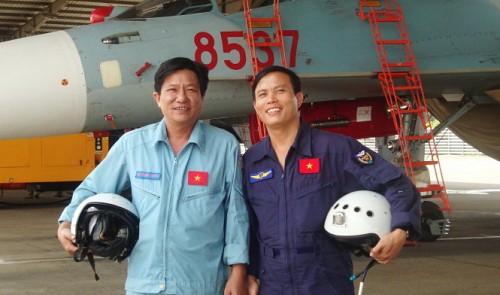Pilots in state-of-the-art Russian Su-30MK2 fighter jets stick to a stringent diet and workout a regime to keep themselves fit for their grueling training flights.
During a recent visit to the 935 Fighter Jet Regiment, stationed in Bien Hoa City, approximately 30 kilometers from Ho Chi Minh City, Tuoi Tre(Youth) newspaper reporters were amazed at the exacting preparation pilots put in for their airborne operations in Su-30MK2 fighter jets.
Su-30MK2, dubbed ‘King Cobra,’ is an improvement on the Su-30MKK – a heavier class, all-weather, long-range strike fighter equipped with track-while-scan and look-down/shoot-down capability.
The Su-30MK2, developed by the Russian Sukhoi Company, is currently employed by air forces around the world, including Vietnam.
Contrary to popular belief that cutting-edge fighters like the Su-30MK2 save pilots a lot of hard work, the ‘King Cobra’ pilots face physically exhausting tasks just as their colleagues in other types of warplane do, according to one of the regiment’s senior pilots.
“During flight, pilots must perform a variety of ‘somersaults,’ which requires supreme physical conditioning and intense concentration, amounting to high stress. Pilots usually lose around one kilogram after each flight drill,” he added.
Workouts an obligation
“It’s not only about pulling and pushing the lever or performing other maneuvers. We’re exposed to constantly changing pressure, and doing ‘somersaults’ at staggering heights,” Colonel Tran Quoc Toan, a first-level pilot, revealed.
“Working out is therefore of crucial importance, and considered a duty. Specialized exercises are designed to boost endurance, stamina, and vestibular function, he noted.
Apart from four exercise routines and two jogging sessions of three to six kilometers on a daily basis, pilots are obliged to complete their compulsory aviation sports regime.
These compulsory sessions, which typically last one to two hours, include endurance running, working out in rotating wheels, on bars and with dumbbells, as well as optional sports. The aviation sports sessions, however, are waived one day before each drill flight.
“The rotating wheel is the most arduous routine, as blood courses into the brain each time. But this exercise is of the most help to pilots during flight,” Col. Toan added.
“During flight, particularly over the sea, doing ‘somersaults’ means facing the blue sky in one instant and the sea in another. Aviation sports routines are intended to prevent pilots from having illusions during such drills,” Pham Van Son, the 935 Fighter Jet Regiment’s sports assistant, explained.
According to Colonel Dao Quoc Khang, the regiment’s political commissar, the day before drills, pilots are not allowed to go home but stay at the base to ensure peak physical condition.
“Pilots sometimes stay put at the base for four or five days on end, though their homes are only a few hundred meters away. They must also go to bed at 9:00 pm sharp,” Col. Khang added.
The men are given health checkups before drills. Only those meeting all the criteria are eligible to take to the skies.
Fighter pilots are always offered privileges regarding clothing, footwear, nutritious diets and accommodation compared to their colleagues in the same unit.
Lieutenant Colonel Le Nhu Hoai, in charge of the regiment’s ordnance, disclosed that fighter pilots’ flight uniforms are overalls adopting Russian designs that meet stringent technical criteria.
The garment is made of fire-proof, absorbent synthetic fibers which allow pilots to feel their best on duty.
Before boarding the Su-30MK2 fighter jets, they also put on ‘anti-pressure pants’ which have amusing cutouts.
In case of overloading, these pants are designed to inflate automatically and exert strong pressure on the wearer’s blood veins, which keeps them from suffering sudden cerebral anemia and dizziness. Jet pilots’ nutritious diets are rich in calories and are meant to offset their energy loss after each airborne mission.
The men are expected to consume every morsel of large helpings including chicken, beef, eggs, vegetables, rice and soup.
Their portions remain the same despite the rise in the cost of food, Lt. Col. Hoai added.
Such helpings, which measure 4,680 calories, are exclusive to pilots.
Fighter pilots’ ranks
Fighter pilots are ranked from levels 0, 3, 2 to 1 in ascending order based on their accumulative flying hours, flight content, climate conditions, and their ability to cope with emergencies and use weaponry, Col. Toan, the first-level pilot, said.
Level-3 pilots have over 400 flying hours in their belt, while their level-2 colleagues boast more than 500.
Those with more than 900 hours are eligible for recognition as first-level pilots, which is a daunting task, particularly over the past 15 years.
“There are several who have more than 900 hours in their career but are denied the recognition. Along with flying hours, the highest rank requires exceptional expertise in tackling emergencies and using weaponry during drill flights,” he noted.
First-level pilots can take off and land their ‘King Cobra’ jets in all kinds of weather.
The 935 Fighter Jet Regiment is currently home to more than 10 first-level pilots, which is a much coveted accolade for all combat regiments.
Senior Lieutenant Colonel Nguyen Khac Hoang, who earned the first-level rank when he was a captain, is currently the youngest officer to achieve the rank in the regiment.

























































